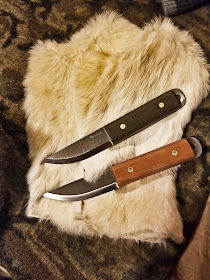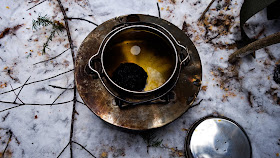I haven't been procrastinating, I've just been doing other stuff, I thought to myself as I stitched the rabbit furs together in the loose form of mittens. This was the second and final pair, they are to be gifts for my daughters on Christmas, tomorrow.
As I was rounding the bend on the last curve, using a locking stitch, I heard the mail truck pull up outside. The dogs were sounding the alarm as usual. I came back inside with several boxes, one of which went to the top of the list for opening.
A pair of the newest Bushcraft USA knives. I'd ordered two as I wanted one for myself and I intend to give the other one away on the BCUSA forums. They set the rabbit fur mitts off, don't you think?
With the mitts done and itching to go outside I shouldered a new hybrid pack and frame I put together from an Alaskan Guide Frame and a Bundeswehr Rucksack. I'll do a write up in the future on this rig, for now I just wanted to go for a walk, make a fire, and drink some tea.
I walked to an area where I've been cutting some fire wood. Good spot to have a fire and a sit. Before I started on the fire fixins I took some shots of the BCUSA knife that I am going to keep.
From the Bushcraft Outfitters listing for these knives:
So I set about gathering some dead standing wood, some birch bark, some low spruce limbs that were dead. I did baton some of the dead standing stuff into smaller pieces. While the blade on the knife is sub 4" it had no problem with this task. One just needs to pick the right wood to work with.
Shaving and feather stick making were also a breeze and quite enjoyable. I had no hot spots with the handle, was able to make fairing fine feathers as seen below.
These are bushmen knives, they do not have the refinements of burled scales, liners, coke bottle shaped handles. They are just as sharp though, mine would shave arm hair out of the box, the spine has one of the sharpest 90s I've ever gotten on a knife. It's a working bushcraft knife from LT Wright, it's a serious knife packing some serious capability into a light and small package.
As per my favorite method of fine making I used the knife's fine edge to scrap up a porous, fibrous, patch of fine birch bark. One slow scrape of the ferro rod on the spine of the knife and viola, fire was had.
With that out of the way I dug my kettle out and added some water. These days I just leave a chunk of chaga in my kettle full time. One chunk about the size seen in the kettle will make multiple kettles of tea. Just add water and settle over the fire.
Obviously this is not a review, just some thoughts on the knife as I received it. Some additional notes, the sheath the knife comes with is perfectly serviceable and good quality leather with a fire steel loop and dangler, it is well stitched and again, high quality. That being said I wanted to try the knife in the sheath I use for my Skookum Bushtool. Pretty much a perfect fit.
Speaking of the Skookum, the two knives are similar in blade length and design, obviously the handles, for those who know skookums', are different. The BCUSA knife is lighter in weight by a few ounces at least.
I'll be back with a more comprehensive piece on the knife in the future. I can say right now, there's nothing wrong with it, it's a great design made by a fantastic knife maker, it's very robust, very sharp, and handles very well.
More to come, thanks to for taking a look.
As I was rounding the bend on the last curve, using a locking stitch, I heard the mail truck pull up outside. The dogs were sounding the alarm as usual. I came back inside with several boxes, one of which went to the top of the list for opening.
A pair of the newest Bushcraft USA knives. I'd ordered two as I wanted one for myself and I intend to give the other one away on the BCUSA forums. They set the rabbit fur mitts off, don't you think?
With the mitts done and itching to go outside I shouldered a new hybrid pack and frame I put together from an Alaskan Guide Frame and a Bundeswehr Rucksack. I'll do a write up in the future on this rig, for now I just wanted to go for a walk, make a fire, and drink some tea.
I walked to an area where I've been cutting some fire wood. Good spot to have a fire and a sit. Before I started on the fire fixins I took some shots of the BCUSA knife that I am going to keep.
From the Bushcraft Outfitters listing for these knives:
The Bushcraft USA Knife is made by LT Wright for us. The steel is 1/8" O-1, which is my personal favorite. The grind is Scandinavian. The blade length is 3.75" with a overall length of 8.25" including the Micarta handle and exposed tang. The spine of the knife is ground to 90 degrees for striking a firesteel and smoothing wood. A brown leather dangler sheath with fire steel loop is included. Handle options include OD Green, Natural Canvas, and Black. These will be available in small batches.I ordered the OD Green and the Natural On a Friday and received them on Monday, during the Christmas rush no less.
So I set about gathering some dead standing wood, some birch bark, some low spruce limbs that were dead. I did baton some of the dead standing stuff into smaller pieces. While the blade on the knife is sub 4" it had no problem with this task. One just needs to pick the right wood to work with.
Shaving and feather stick making were also a breeze and quite enjoyable. I had no hot spots with the handle, was able to make fairing fine feathers as seen below.
These are bushmen knives, they do not have the refinements of burled scales, liners, coke bottle shaped handles. They are just as sharp though, mine would shave arm hair out of the box, the spine has one of the sharpest 90s I've ever gotten on a knife. It's a working bushcraft knife from LT Wright, it's a serious knife packing some serious capability into a light and small package.
As per my favorite method of fine making I used the knife's fine edge to scrap up a porous, fibrous, patch of fine birch bark. One slow scrape of the ferro rod on the spine of the knife and viola, fire was had.
With that out of the way I dug my kettle out and added some water. These days I just leave a chunk of chaga in my kettle full time. One chunk about the size seen in the kettle will make multiple kettles of tea. Just add water and settle over the fire.
Obviously this is not a review, just some thoughts on the knife as I received it. Some additional notes, the sheath the knife comes with is perfectly serviceable and good quality leather with a fire steel loop and dangler, it is well stitched and again, high quality. That being said I wanted to try the knife in the sheath I use for my Skookum Bushtool. Pretty much a perfect fit.
Speaking of the Skookum, the two knives are similar in blade length and design, obviously the handles, for those who know skookums', are different. The BCUSA knife is lighter in weight by a few ounces at least.
I'll be back with a more comprehensive piece on the knife in the future. I can say right now, there's nothing wrong with it, it's a great design made by a fantastic knife maker, it's very robust, very sharp, and handles very well.
More to come, thanks to for taking a look.































